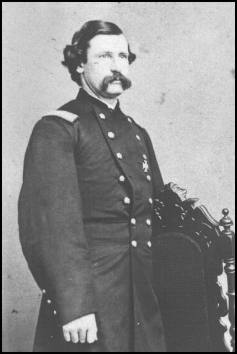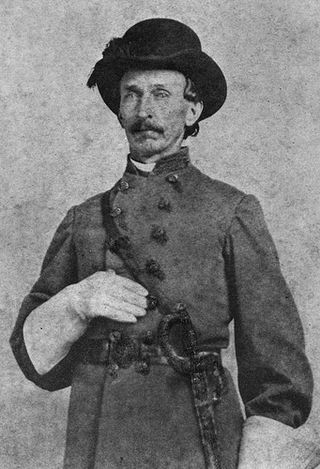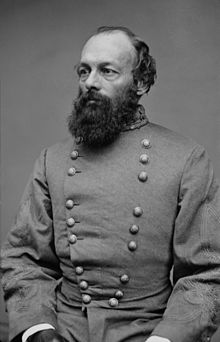
St. Augustine is a city in and the county seat of St. Johns County located 40 miles south of downtown Jacksonville. The city is on the Atlantic coast of northeastern Florida. Founded in 1565 by Spanish explorers, it is the oldest continuously inhabited European-established settlement in what is now the contiguous United States.

The Confederate States Army, also called the Confederate Army or the Southern Army, was the military land force of the Confederate States of America during the American Civil War (1861–1865), fighting against the United States forces to win the independence of the Southern states and uphold and expand the institution of slavery. On February 28, 1861, the Provisional Confederate Congress established a provisional volunteer army and gave control over military operations and authority for mustering state forces and volunteers to the newly chosen Confederate president, Jefferson Davis. Davis was a graduate of the U.S. Military Academy, and colonel of a volunteer regiment during the Mexican–American War. He had also been a United States senator from Mississippi and U.S. Secretary of War under President Franklin Pierce. On March 1, 1861, on behalf of the Confederate government, Davis assumed control of the military situation at Charleston, South Carolina, where South Carolina state militia besieged Fort Sumter in Charleston harbor, held by a small U.S. Army garrison. By March 1861, the Provisional Confederate Congress expanded the provisional forces and established a more permanent Confederate States Army.

Nathaniel Lyon was the first Union general to be killed in the American Civil War. He is noted for his actions in Missouri in 1861, at the beginning of the conflict, to forestall secret secessionist plans of the governor Claiborne Jackson.

The Castillo de San Marcos is the oldest masonry fort in the continental United States; it is located on the western shore of Matanzas Bay in the city of St. Augustine, Florida.

Horatio Gouverneur Wright was an engineer and general in the Union Army during the American Civil War. He took command of the VI Corps in May 1864 following the death of General John Sedgwick. In this capacity, he was responsible for building the fortifications around Washington DC, and in the Overland Campaign he commanded the first troops to break through the Confederate defenses at Petersburg. After the war, he was involved in a number of engineering projects, including the Brooklyn Bridge and the completion of the Washington Monument, and served as Chief of Engineers for the U.S. Army Corps of Engineers.

Fort Dallas was a military base during the Seminole Wars on the banks of the Miami River in what is now Downtown Miami, Florida, United States.

Martin Davis Hardin was a brigadier general in the Union Army during the American Civil War. He was appointed a brigadier general on July 6, 1864, to rank from July 2, 1864, the date of U.S. Senate confirmation of his promotion.

Florida participated in the American Civil War as a member of the Confederate States of America. It had been admitted to the United States as a slave state in 1845. In January 1861, Florida became the third Southern state to secede from the Union after the November 1860 presidential election victory of Abraham Lincoln. It was one of the initial seven slave states which formed the Confederacy on February 8, 1861, in advance of the American Civil War.

During the American Civil War (1861–1865), Washington, D.C., the capital city of the United States, was the center of the Union war effort, which rapidly turned it from a small city into a major capital with full civic infrastructure and strong defenses.

States Rights Gist was a lawyer, a militia general in South Carolina, and a Confederate Army brigadier general who served during the American Civil War. A relative of several prominent South Carolinians, Gist rose to fame during the war but was killed at the Battle of Franklin on November 30, 1864. His name was based on the Southern states' rights doctrine of nullification politics of his father, Nathaniel Gist. Nathaniel Gist was a disciple of John C. Calhoun and chose his son's name to reflect his own political sentiments.

Daniel P. Tyler IV was an iron manufacturer, railroad president, and one of the first Union Army generals of the American Civil War.

William Wing Loring was an American soldier who served in the armies of the United States, the Confederacy, and Egypt.

Henry Livermore Abbott was a Major in the Union Army during the American Civil War. Abbott was posthumously awarded the grade of brevet brigadier general, United States Volunteers, to rank from August 1, 1864, and the grades of brevet lieutenant colonel, brevet colonel and brevet brigadier general, United States Army, all to rank from March 13, 1865 for gallant and meritorious services at the Battle of the Wilderness, where he was killed in action. Abbott was engaged at the center of several key Civil War battles and was widely known and admired for his leadership, courage and composure under fire.

As a fervently abolitionist and strongly Republican state, Maine contributed a higher proportion of its citizens to the Union armies than any other, as well as supplying money, equipment and stores. No land battles were fought in Maine. The only episode was the Battle of Portland Harbor (1863) that saw a Confederate raiding party thwarted in its attempt to capture a revenue cutter.
The 10th Connecticut Infantry Regiment was one of Connecticut's most successful civil war regiments, compiling an exemplary record of service in the Union Army. The 10th Regiment saw action in the coastal campaign during the early years of the war, which culminated with the siege of Charleston. The 10th went on to fight the trench battles of Richmond, earning praise from Union generals and Ulysses S. Grant. The 10th was active at the war’s very end, when they blocked Robert E. Lee’s attempt to escape from Virginia. And, the 10th was present at Appomattox Court House when Lee surrendered to Grant. All told, the 10th regiment fought in twenty three battles and at least as many skirmishes.
Italian Americans in the Civil War are the Italian people and people of Italian descent, living in the United States, who served and fought in the American Civil War, mostly on the side of the Union. A contingent of soldiers from the former Kingdom of the Two Sicilies fought on the Confederate side, with most of these having been former prisoners of war who had fought against Giuseppe Garibaldi during his invasion of the Two Sicilies. Between 5,000 and 10,000 Italian Americans fought in the civil war.

John Jackson Dickison, known as J. J. Dickison, was an officer in the Confederate States Army during the American Civil War. Dickison is mostly remembered as being the person who led the attack which resulted in the capture of the Union warship USS Columbine in the "Battle of Horse Landing". This was one of the few instances in which a Union warship was captured by land-based Confederate forces during the Civil War and the only known incident in U.S. history where a cavalry unit sank an enemy gunboat. Dickison and his men were victorious in all of his raids against the Union troops in Florida, including his raid in Gainesville what is known as the Battle of Gainesville. Tragedy struck Dickison, when one of his sons, both of whom served under his command, was killed during a raid.

The Saint Augustine Blues, also known as the Independent Blues, were a militia unit that fought for the Confederacy during the American Civil War. After serving in the local community, the unit was eventually organized into the Third Florida Infantry where it fought in several engagements including the campaigns of the Army of Tennessee.
Joseph H. Tucker was a banker, businessman and Illinois militia colonel during the first two years of the American Civil War. He was given initial responsibility for building Camp Douglas at Chicago, Illinois, and was the first commander of the camp. Originally a training camp for Union Army recruits, in 1862 and 1863 Camp Douglas was converted into a prison camp for Confederate States Army prisoners captured by the Union Army. Tucker was commander of the camp from the start of its construction in October 1861 until September 28, 1862, except between February 26, 1862, and June 19, 1862. During this time, the camp was used as a training facility and had its initial use as a prisoner of war camp. Tucker was never mustered into the Union Army, remaining a colonel in the Illinois militia during the term of his service in the Civil War.
St. Augustine, Florida, the oldest continuously occupied settlement of European origin in the continental United States, was founded in 1565 by Spanish admiral Pedro Menéndez de Avilés. The Spanish Crown issued an asiento to Menéndez, signed by King Philip II on March 20, 1565, granting him various titles, including that of adelantado of Florida, and expansive privileges to exploit the lands in the vast territory of Spanish Florida, called La Florida by the Spaniards. This contract directed Menéndez to explore the region's Atlantic coast and report on its features, with the object of finding a suitable location to establish a permanent colony from which the Spanish treasure fleet could be defended and Spain's claimed territories in North America protected against incursions by other European powers.



















